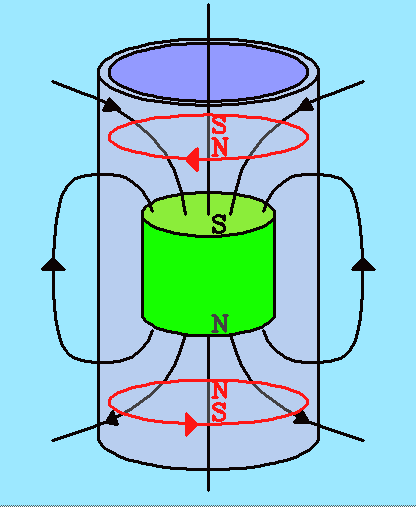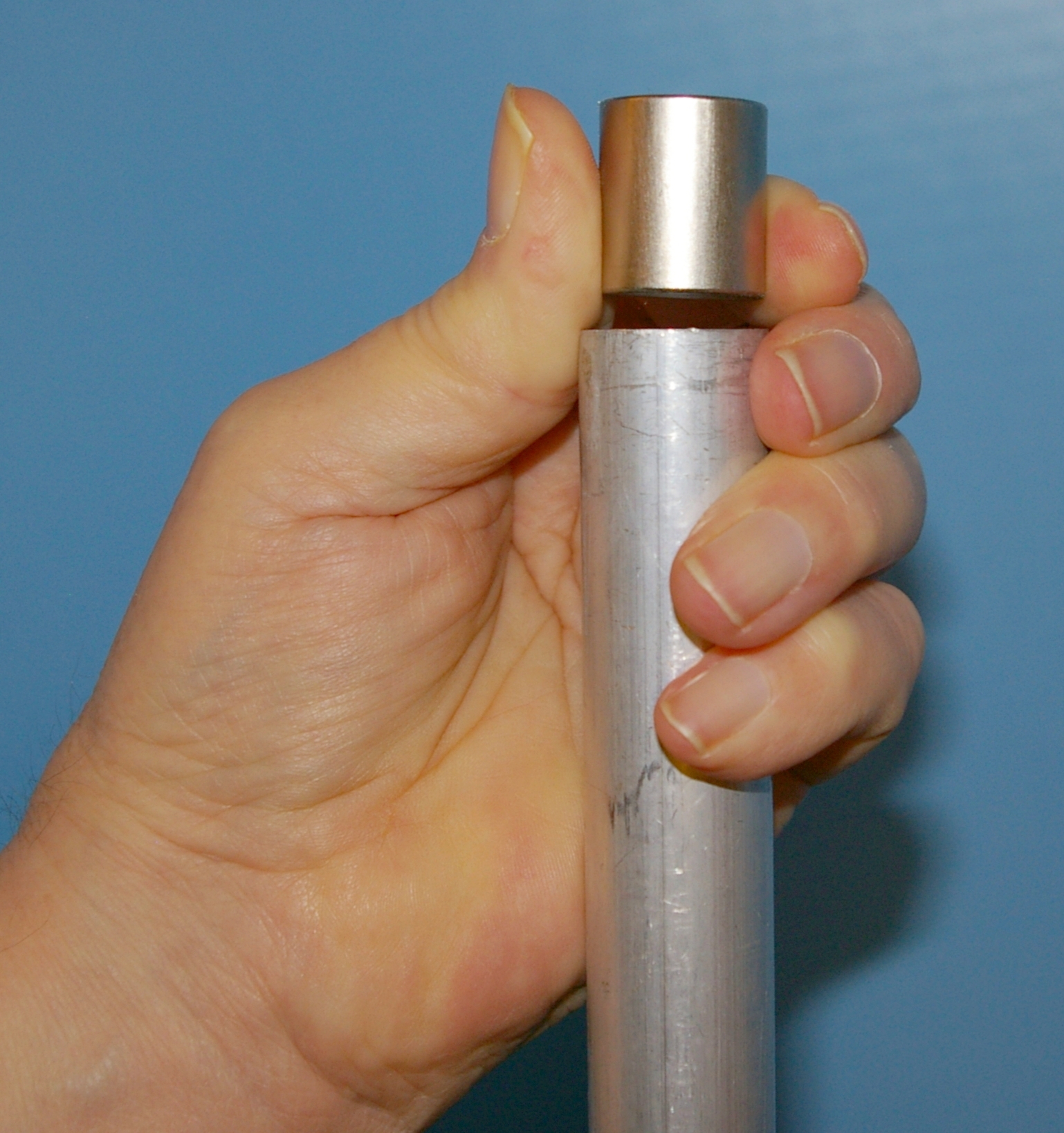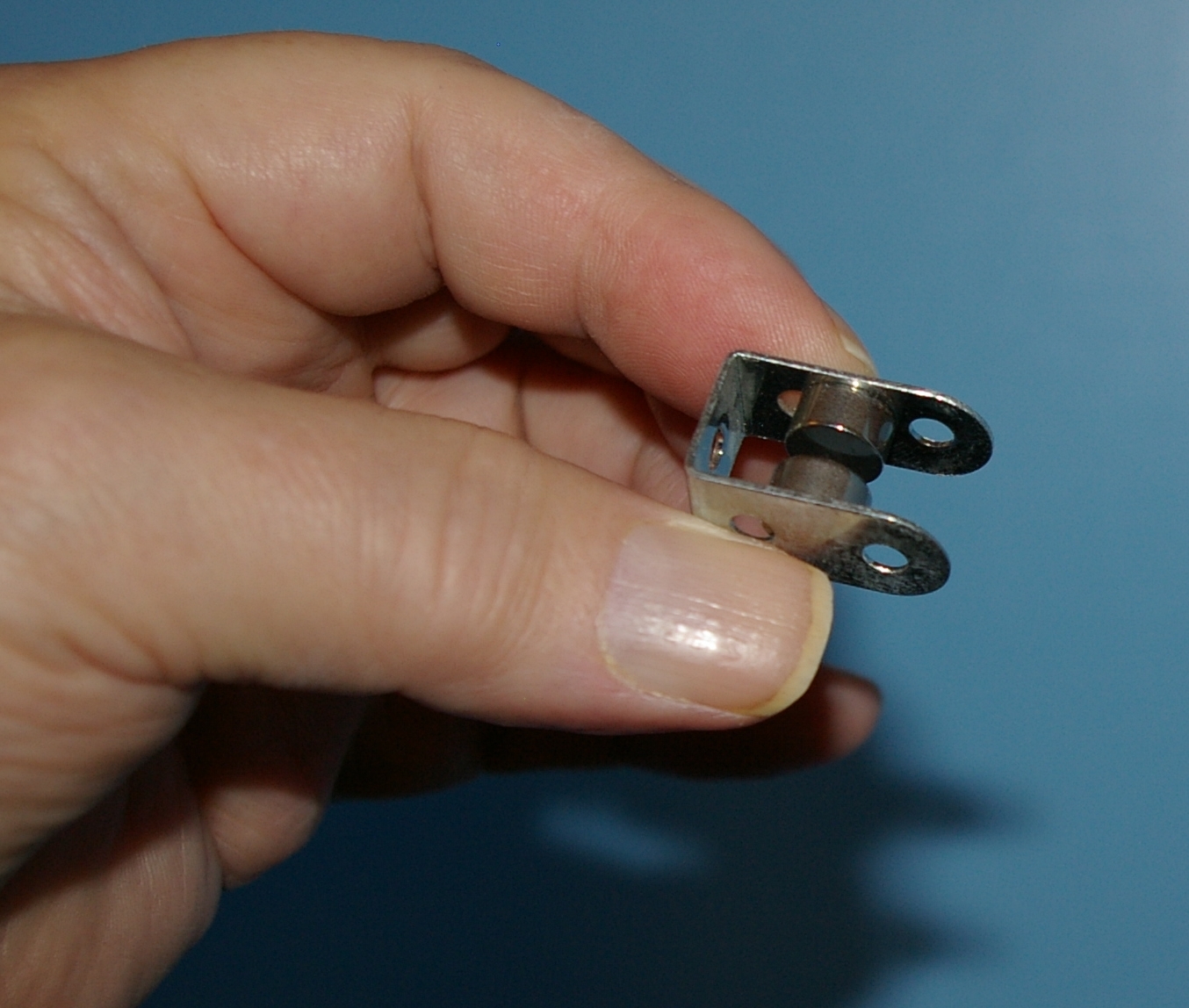THE SLOW FALL
[New text in purple.]
|
Aristotle wrote that falling bodies descended to earth with constant speed. Galileo showed that in fact they fall with constant acceleration, that is, they speed up continually. Unsupported bodies, like stones, fall downward with an acceleration of about 9.8 m/s2 (32 ft/s2) if air drag is negligible. Some bodies, like falling leaves or sheets of paper, do fall more slowly, but usually don't fall in a straight line downward. So a body falling slowly downward in a straight path, with constant speed, is something we are not used to seeing. One way to make this happen is to drop a solid body into a container of transparent viscous material, such as glycerin, or corn syrup. Far less messy is to use electromagnetic induction.
Very strong Neodymium Iron Boron (NdFeB) rare earth magnets are available in many sizes and shapes, clyinder, disk and spherical. They are relatively inexpensive. Such a magnet, when dropped down a vertical non-ferrous metal tube, will descend surprisingly slowly. Complete apparatus for this experiment can be purchased from scientific supply houses. It consists of a 5 foot long aluminum tube and a strong cylindrical magnet that fits loosely inside the tube. Some commercial versions, with shorter tubes, have holes in the side of the tube so you can watch the magnet's slow progress.
You can make your own apparatus for less cost. One inch diameter aluminum tubing is available in hardware stores in 6 foot lengths. A 3/4 inch diameter cylindrical magnet fits loosely inside (Fig. 1). The tube can be any non-ferrous metal of good conductivity, such as copper or aluminum. 1/2 inch OD tube may be used with a 7/16 inch diameter magnet. Shorter tubes may be used.
Drop a small rubber ball down the vertical tube to demonstrate how quickly it falls. Then drop the magnet down the tube. People expect it to emerge quickly, but it takes its sweet time. Some suppose it is stuck inside the tube. As it finally emerges from the bottom of the tube it then speeds up. Catch the magnet in your hand as it leaves the tube, or let it fall into a padded box to prevent it hitting the floor and shattering.
If the magnet is small enough, it can be dropped down the tube in any orientation. Note that if a small magnet is dropped into the tube edgewise, it will turn as it falls and emerge oriented with its poles along the up/down line.
The reason it works. So why does the magnet fall so slowly? The moving field of the magnet exerts force on free electrons in the metal tube, setting up induced electron currents around the circumference of the tube. Moving electrons have a magnetic field of strength proportional to their speed. The magnetic field of all these moving electrons acts in a direction to oppose the motion of the magnet.
This is an example of Lenz's law: A changing magnetic field induces currents in conductors. These induced currents produce a magnetic field that opposes the change that induced it. [Heinrich Friedrich Emil Lenz (1804–65), 1834.] Lenz's law is a consequence of Newton's third law, which says that if body A exerts a force on body B, then B exerts an equal size but oppositely directed force on body A. One could get into the messy details of the laws of these fields, currents and forces, but Lenz's law says it all concisely. In other words, "An induced current is always in such a direction as to oppose the motion or change causing it". This applies to the magnet falling in the tube as well as all the variations of this demonstration described below. If a cord were attached to the magnet and it were pulled upward through the tube, the induced currents would exert a downward force on it, opposing the magnet's motion as Len's law predicts. Isn't nature perverse?
So the motion of the falling magnet is opposed by the upward forces due to these induced currents. The size of the induced currents very quickly increases until the upward force on the magnet matches the size of the downward force due to gravity. But by the time this happens, the magnet is already moving downward, and continues to move downward at constant speed, since the net force (gravity plus magnetic) on it is now zero, its acceleration is zero and its speed is constant.
The diagram gives a schematic idea of what's going on, at the introductory physics level. A few of the falling magnet's field lines are shown (in black). Where these intersect the walls of the metal tube they exert force on free electrons, inducing currents all along the tube's length near the magnet. Only two of these current loops are shown (in red). These current loops produce magnetic fields as if they were magnets, with polarities as shown (also in red). Like magnetic poles repel, opposite poles attract. So these currents exert forces upward on both the magnet's N and S poles. Of course this is descriptive only, for there are some interesting details involving the Lorentz force on moving electrons that we will spare you, for the explanation of the geometric relations would be lengthy. The interesting thing is that the other demonstrations described below all depend on the very same laws of physics, but the geometry is very different.

Fig. 2. The physics.
Falling sphere. Nickel-plated magnetized rare earth spheres are also available from many internet sources. Obtain such a spherical magnet that is slightly smaller than the inside diameter of the tube. The sphere will fall slowly down the tube just as the cylinder did. Mark the magnet "poles" with small colored stickers. Now watch the sphere from above as it falls down the tube. Does the sphere always rotate and re-orient so that one of the poles is up, and the other down? Or does it re-orient with the magnetic axis horizontal? Why?
Caution! These magnets are very strong compared to their weight, and can affect objects more than a foot away. Do not place them near credit cards, computers, VCRs, TVs, cell phones, pacemakers, computer disks, magnetic tape, or any magnetic computer storage media. The nickel plating prevents scratching and chipping of the magnets, but they are still fragile, and should not be allowed to strike each other, or other objects, for small, sharp chips could be knocked off.Treat small magnets just as you treat prescription drugs: do not put them where children can find them, for children will put anything in their mouths. A swallowed magnet will pass, but if two magnets are swallowed separately, or a magnet and a ferrous metal object are swallowed, they can be attracted to each other with an intestinal wall between, perforating the intestine.
THE VISIBLE SLOW FALL
|
The trouble with the previous demonstrations is that you can't watch the magnet during its fall and can't appreciate that nearly the entire fall is at constant speed. So some years ago I devised an improved version, which has lots of advantages.
I use a 4 or 5 foot long bar of aluminum, with 1/10 inch by 3/4 inch cross section. It cost only a few dollars. I acquired two cylindrical plated rare earth magnets, 11mm diameter by 5mm thick. They cost about 1 dollar each. The package says each will lift 5 pounds. Using a soft iron strap about 3/4 inch wide, I fashioned a rectangular frame about 5/8 by 1 1/4 in. The magnets (grey) hold themselves on the inside of the frame, leaving exposed poles about 5 mm apart. The magnets have their opposite poles facing each other, and once assembled the entire thing acts like a single magnet with a small gap between opposing poles. (See Fig. 3.) This frame fits loosely over the aluminum strip. When dropped, it glides gently down the aluminum strip, at slow and constant speed.
|
Even easier to make is the version I photographed here (Figs. 4 and 5.). I used a U-shaped steel bracket from a Meccano construction set. (Meccano part 102, single bent strip.) It is a bit heavier on one side, so you need to hold the aluminum bar at a slight angle to the vertical so the falling magnets don't wander offside.
|
These "open" versions have another advantage. You can hold the magnet frame in your hand and move it back and forth along the aluminum strip, feeling the opposition of the forces to the magnet's motion, whichever direction you move.
Notice that in both of these demonstrations, the magnet aligns itself to fall without touching the aluminum tube or strip, so there's negligible friction.
Simpler and simpler
Strong magnets are available in ring or donut form. Find one that just fits over an aluminum rod. I find this version isn't as dramatic in its speed reduction as the version described above. I like to put a colored wooden bead and a donut magnet on the rod, with the bead below the magnet. Release both at once. The bead falls quickly; the magnet takes more time. It's a hare and tortoise race toy. Invert the rod, and the bead and magnet fall slowly, the bead riding on top of the magnet.
Slow rolling.
|
Someone once asked me whether a cylindrical magnet rolling on a tilted aluminum sheet will be impeded by eddy currents. Surely such currents must also be induced by a rolling magnet, but the geometry of the situation makes them relatively ineffective. However, here's a way to make a disk magnet roll slowly, using 1 inch angle aluminum stock (standard hardware store item in 6 or 8 ft lengths). The disk magnet (magnetized along its cylinder axis) rolls with one face close to one face of the aluminum track. (Fig. 6.)
The aluminum angle stock may also be used as a track for spherical magnets.
As with most of my projects, most dimensions are not critical. Be creative.
{End of MAKE article.}
Large versions of the pictures:
Fig. 1. Dropping magnet into the tube.




